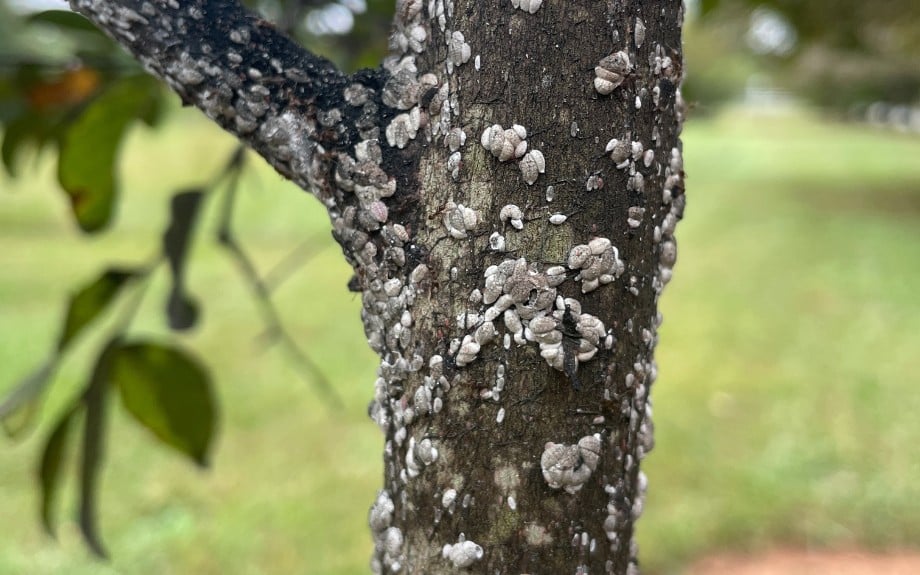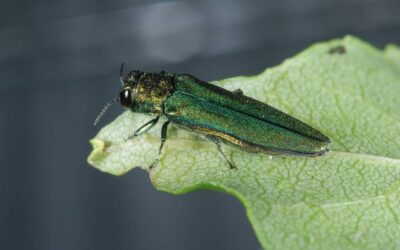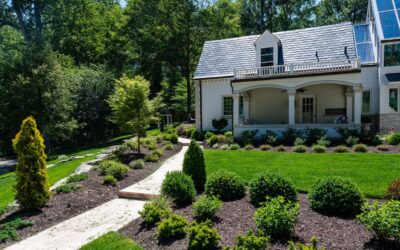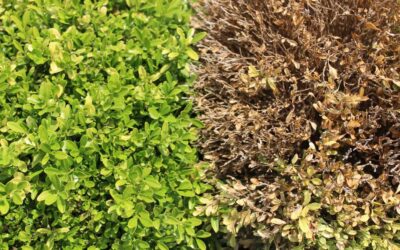Blog Topics
What looks like harmless white fuzz could be a much bigger problem. Crape myrtle bark scale (CMBS) is taking hold in Northern Virginia, and if your trees look stressed or covered in cottony patches, you may already have it.
Let’s break down what CMBS is, how to identify it, and, most importantly, how to treat it before it takes over.
Key Takeaways
- Crape myrtle bark scale (CMBS) is an invasive Asian pest that has been spreading throughout Virginia since 2014, appearing as white, waxy insects on tree bark.
- Signs of an infestation include white cotton-like insects on branches, black sooty mold on leaves and bark, and trees with reduced growth and fewer blooms.
- While CMBS typically won’t kill healthy crape myrtles, it causes significant stress and reduces the ornamental value of these popular landscape trees.
- Prevention is the best strategy and includes planting trees in full sun, buying pest-free nursery stock, maintaining tree health, and encouraging natural predators like ladybird beetles.
- Treatment options range from light pruning of infected branches to professional soil drench applications in spring, with the most effective treatments targeting the “crawler” stage of the pest’s life cycle.
What Is Crape Myrtle Bark Scale
Crape myrtle bark scale (Acanthococcus lagerstroemiae) is an invasive pest originally from Asia. It first appeared in Virginia in 2014 and has since become a widespread problem across Fairfax County and surrounding areas. Most infestations are introduced through infested nursery stock, but once established, these pests can spread quickly from tree to tree.
These insects are small and oval-shaped, with a pink body that looks like it’s covered in a white or grey waxy coating. Females lay between 100 and 300 eggs, which hatch into mobile “crawlers” that are active in spring. Crawlers can spread through wind or by moving to nearby trees.
In Northern Virginia, CMBS typically has two generations per year (compared to up to four in warmer southern states). As they mature, the insects settle on bark or branches, develop their wax covering, and begin feeding on the tree’s sap. While crape myrtle bark scale won’t kill your trees, it will cause significant stress and make the more vulnerable to other problems.

Photo of crape myrtle bark scale by m.borden, CC BY-SA 2.0, via Wikimedia Commons
Signs of Crape Myrtle Bark Scale
One of the first signs of crape myrtle bark scale is the insects themselves. They’re easy to spot thanks to their white, waxy coating – especially when clustered together along the same branch.
Another telltale sign is honeydew, a sticky substance these insects excrete as they feed. Honeydew attracts ants and other pests, and it also promotes the growth of sooty mold – a dark, grimy fungus that often coats leaves, bark, and even the ground below your trees.
Beyond these visible clues, your crape myrtles will start to show stress. Infested trees may:
- Leaf out later in the spring
- Produce fewer blooms and smaller flower clusters
- Exhibit reduced overall vigor and growth

Photo of a heavy infestation of crape myrtle bark scale by m.borden, CC BY-SA 2.0, via Wikimedia Commons
Trees and Shrubs Affected by Crape Myrtle Bark Scale
Don’t let the name fool you – crape myrtle bark scaled doesn’t just affect crape myrtles. While these ornamental trees are the most common hosts (especially hybrid cultivars like ‘Natchez’ and ‘Muskogee’), they’re not the only ones at risk.
CMBS has been found on several other tree and shrub species, including:
- Persimmon
- Korean Boxwood
- Fig
- Pomegranate
- St. Johnswort
- American Beautyberry
If you have any of these plants in your landscape – especially near infected crape myrtles – keep a close eye on them for signs of an infestation.
How to Treat Crape Myrtle Bark Scale
Crape myrtle bark scale is not usually life-threatening to your trees, which means aggressive treatments are typically not necessary. However, if the pest is harming your tree’s appearance, there are treatment options available, such as:
- Pruning Infected Branches: Light pruning of the most severely infested branches will remove many pests at a time. Just be sure to avoid removing too many branches, as this can further stress your tree and harm its appearance.
- Chemical Treatments: Soil drenches in the spring before crape myrtles leaf out can help control CMBS populations. We usually recommend the first treatment in April in most years.
- Insecticidal Soap: Using insecticidal soaps during the crawler period can kill them. However, it won’t have much of an effect on CMBS once they have their protective covering. Avoid using any insecticidal soap if you have a professional perform a soil drench or if there is a substantial presence of beneficial insects on the tree.
- Dormant Oil: Using a dormant oil in the winter can help kill overwintering CMBS. Depending on how hot it is, you may be able to wait until late spring to apply this oil.
- Scrubbing Branches: Lightly scrubbing branches with water and a mild detergent can dislodge and kill CMBS. This also allows you to remove some of the black sooty mold that develops from the honeydew they leave behind.
“We always recommend starting with a professional evaluation before jumping into treatment. In some cases, a heavy infestation may warrant chemical treatment, but often, improving overall tree health and using less aggressive methods can be just as effective – especially if we catch it early.” – Peter Hart, ISA Certified Arborist at Riverbend Landscapes & Tree Service
How to Prevent Crape Myrtle Bark Scale in Northern Virginia
The best defense against crape myrtle bark scale is stopping it before it becomes a problem. Here are several proactive steps you can take to prevent CMBS from establishing in your trees:
- Plant Trees in the Right Place: Choose a planting spot for your crape myrtles that gets full sun (at least six hours daily). Ample sun discourages CMBS from attempting to colonize your tree.
- Inspect New Trees Before Planting: Crape myrtle bark scale often spreads when infested trees are purchased from nurseries. Before bringing a new tree home, carefully inspect the bark for any signs of white fuzz or scale insects to avoid introducing the pest into your landscape.
- Keep Your Tree Healthy and Resilient: Stressed trees are more vulnerable to pests like crape myrtle bark scale. Support your tree’s health with proper watering, pruning, and care. Also, go easy on the nitrogen fertilizer, as too much can actually make your tree more appealing to scale insects.
- Encourage Natural Predators: Many beneficial insects, such as ladybird beetles, feed on scale. By planting flowers and keeping your yard generally healthy, you can encourage more of these natural predators that will help control CMBS infestations.
Frequently Asked Questions About Crape Myrtle Bark Scale in Northern Virginia
We get calls and questions from homeowners all the time about crape myrtle bark scale. To help calm your worries about your crape myrtles, we’ve answered some common questions below to arm you with knowledge about CMBS.
Why is crape myrtle bark scale so difficult to control?
CMBS, like most scale insects, is challenging to control because of their protective coating in adulthood. The waxy covering makes them more easily identifiable but protects them from most sprays and chemicals. The most effective time to treat CMBS is during the crawler stage, but this is a small window.
Should I remove my crape myrtle and replace it with another species to protect against CMBS?
No, you do not need to remove a crape myrtle preemptively because of CMBS. There are many ways to prevent or control populations of CMBS and reduce the harm your tree faces. However, if you are worried about your young crape myrtles, have an arborist inspect them to give you a prognosis about their health.
Besides crape myrtle bark scale, what other pests or diseases should Northern Virginia homeowners watch for?
Some other pests and diseases to watch for in Northern Virginia include:
- Spider mites
- Boxwood blight
- Ambrosia beetles
- Beech leaf disease
- Emerald ash borer
- Leaf-eating caterpillars

Worried About Your Crape Myrtle Trees? Let Riverbend Restore Their Health
If you’ve spotted white fuzz on your crape myrtle, it’s likely a sign of crape myrtle bark scale. But don’t worry, it is treatable. At Riverbend Landscapes & Tree Service, our ISA Certified Arborists specialize in diagnosing and treating tree pests like CMBS across Northern Virginia.
We’ll inspect your trees, confirm the problem, and create a customized treatment plan to help your crape myrtles bounce back stronger and healthier. Call us today at 703-402-9366 or request an estimate online.
Give Us a Call at 703-402-9366
If you'd like help with your trees or landscape, have any questions, or would like to schedule an appointment with one of our Certified Arborists, please give us a call. We'd love to hear from you!



